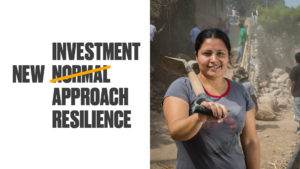Turning risk into resilience – tackling the climate crisis in unexpected ways
With a shift in priorities, investment and policy, we can transform our systems in response to the biggest threat facing humanity today, for a brighter and more sustainable future. Our work is helping break the vicious cycle of disaster vulnerability for those most at risk – and building climate resilience instead.
In our last article, Why settle for normal?, we explored how business as usual will only lead to more disasters, more poverty and widening injustice for millions of people living on the frontline of climate change. This article outlines our call to action based on our ingenious recipe for success.
“Modern man does not experience himself as a part of nature but as an outside force destined to dominate and conquer it. He even talks of a battle with nature, forgetting that, if he won the battle, he would find himself on the losing side.”
E.F. Schumacher, Practical Action’s founder
#1 Working with nature – to protect people and the planet
There are better alternatives to this form of destructive development and alternative solutions that minimize the impacts of disasters. Solutions that meet people’s needs, while protecting and regenerating nature.
One example is bio-dykes. They are an environmentally friendly alternative to normal flood defenses, where ‘normal’ means huge concrete structures that are expensive to build, damage the environment and are catastrophic when they fail.
The benefits of bio-dykes 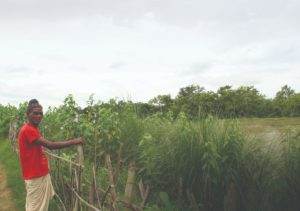
- They save lives and property by mitigating and reducing the risk of floods
- They reduce the financial losses incurred by individuals as a result of property damage or livelihood interruption
- They require significantly less investment than typical flood defense infrastructure, and can be built using local materials, and built by local workers without specialist skills
- They can be managed and run locally, which reduces maintenance and ongoing costs and builds social cohesion as communities work together to plan, build and maintain them
- A range of tree types can be planted on them, which can be sold for fuel, fodder or medicinal use, creating new income opportunities
- The tree roots bind the soil and help prevent erosion, maintaining the original flow of the river
- They create new habitats for wildlife, which helps to increase biodiversity and leaves existing ecosystems undisturbed.
Bio-dykes deliver economic, environmental and social benefits. They really are a win, win, win solution – unlocking the triple dividend of resilience in terms of saving lives and avoiding losses when disasters strike, stimulating local economic activity, and delivering additional development co-benefits. Even if predicted floods don’t happen in the Karnali river in Nepal, bio-dykes have been instrumental in protecting communities’ homes, agricultural land and public infrastructure, reversing the annual cycle of flood losses and increasing the confidence of communities to invest in long term land and farm productivity.
This innovative use of bio-dykes has been recognized by the government of Nepal, who have prioritized bio-dykes and other nature–based solutions in their annual national budget allocated for flood protection.
Since the introduction of a bio-dyke, impacts of floods are minimized, there is an increase in crop production, livestock and houses are saved, pressure on natural resources is decreased, and women are saving time otherwise spent for the collection of forest products.”
Participant of a focus group discussion held in Bardia District in Nepal
#2 Building community resilience – to break the cycle of vulnerability
The only way to build long–term resilience is to start at the community level with those who experience the worst effects of the climate crisis. These are the people who know the strengths, vulnerabilities and needs of their community best.
We look at the whole picture – helping people prepare for what’s thrown at them, shorten their disaster risks odds, and survive and prosper despite the changing climate.
Forewarned and forearmed
In many parts of the world, underlying poverty, remoteness, lack of healthcare or no electricity means people are already vulnerable. The impact of climate change is yet another burden that can tip them over the edge, particularly when sudden shocks such as floods, storms or landslides hit.
Being forewarned and forearmed can make the difference between a disaster that pushes people deeper into poverty and successfully coming through the shock and moving forward. Joined up early warning and climate information systems offer people this opportunity.
A case study from Bangladesh: hear, understand, respond
An example of our success in this area can be found in our work in In Bangladesh. We collect forecast information from the national Flood Forecasting and Warning Center (FFWC), convert it into local languages and send it as voice messages to communities, so that everyone can understand it. This is particularly important in communities where illiteracy may be high.
“We are sending localized voice messages to communities based on the upstream flood information compiled by FFWC. The communities receiving the messages have told us that the messages are really helpful for them to gather their valuables and livestock and assemble to nearest shelters and they would not have been able to do that in the absence of the messages.”
Afsari Begum, Practical Action, Bangladesh
With information successfully sent and understood, we work with communities to empower them to prepare and respond. The community disaster management committees or local response groups meet regularly, conduct preparatory drills, check the stockpile to be used in case of emergency and make plans for who should be evacuated or supported in the first place during the emergency.
Empowered to succeed
The real transformation comes with knowledge of what to do with information beyond the immediate threat, and how to integrate long term changes in lives and livelihoods.
Together with Zurich Flood Resilience Alliance, we have developed a comprehensive method and tool to measure the resilience of flood vulnerable communities. We have used the Flood Resilience Measurement for Communities (FRMC) in Nepal, Bangladesh and Peru, where we empower people by increasing their understanding of risk and help them identify actions to build flood resilience in their lives and livelihoods.
Our 3-point approach
- Work with the most marginalised and vulnerable communities to identify and incorporate their needs
- Explore risk across all sectors and think of solutions that work across multiple ones
- Build from what communities already have and don’t raise expectations based on what they want.
Communities identify what they need to build their resilience and advocate local government to increase investment in resilience building activities.
This approach has empowered communities to shape the local government development planning process and the budgets allocated to these plans. By capturing the collective voice of the community and following formal process introduced these requests into higher echelons of the local planning process, we have been able to increase investment in not only response budgets but also increased budgets for anticipatory action prior to the event.
For example, building on the successes of our flood shelters, the local governments are not only building their own shelters and importantly allocating budgets for their routine maintenance.
“The FRMC approach and sharing of the evidence generated during the local government planning process has enabled the local governments we are working with to prioritize risk reduction measures in their development planning, a clear shift from traditional response focused interventions.” Bikram Rana, Practical Action, Nepal.
More Resilient Livelihoods
We work with the communities so that they can integrate immediate and long–term climate risks in their lives and livelihoods. These include identification and implementation of alternative income generating opportunities, changing the farming practices as well as the ways of building houses.
For example, resource–poor communities in South West coastal region of Bangladesh worked with us to innovate, a food production system that combines fish farming and vegetables production in a stressed soil and water environment for quick return of investment. This technology fits into the diverse systems such as rivers, canals, large water basins where poor people live nearby natural waterbodies.
Elsewhere in Bangladesh, communities built raised structures to keep their goats and poultry safe from flooding and downpours. As the raised shelters helped avoid loss of goats or poultry, the communities expanded the size of such shelters from the savings made so that they can keep their other valuables safe during flooding.
Aquageoponics in Bangladesh
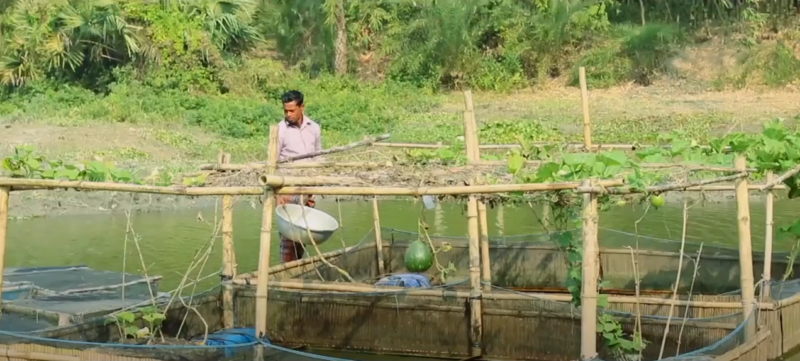
“This year in addition to COVID, we are experiencing floods not seen in the last 15-20 years. With the raised sheltering we are able to avoid flood washing away our goats and poultry. With Covid, we don’t have any other work to do at the moment but the income from selling our mature goats and poultry will provide us savings to sustain during these hard times.”
Local community member from flood resilience project site in Bangladesh
#3 Influencing decision-makers – to make big change possible
Coordinated efforts at a national and global level are needed to reduce emissions, promote green economies, finance the just transition, and ramp up climate-wise investment into locally developed solutions that reach the most vulnerable.
We have a long history of bringing people together in bold collaborations to challenge the status quo – ensuring the local perspective is heard in global debates, and vice versa, to create an inclusive policy and investment landscape.
“Global policy processes are desperate for robust evidence from the ground. Through our engagement with climate negotiations, we are continuously showcasing what works for the world’s poorest and most marginalized. We do our best to share the voices of the people from the ground.” Robert Sakic Trogrlic, Practical Action
Shaping national policies in Peru and around the world
We recognised gaps in coverage of the national weather service in Peru and saw how this lack of data was preventing effective planning. In response, we encouraged the formation of a local network of volunteers to collect daily rainfall data and report this using a simple What’s App group.
We shared the data that was collected with Peru’s national weather service. They found it extremely valuable and, as a result, the Government have implemented a national policy promoting the collection of daily weather data by voluntary groups across the country.
This community-first approach is something we’ve replicated around the world, with similar success.
“Recognising our long-standing work in climate and resilience, and our partnership with government agencies in supporting the development of climate change policies, strategies, and framework, we have been invited as a member of the disaster risk reduction and management thematic working group in the National Adaptation Planning (NAP) formulation process.”
Dharam Uprety, Practical Action, Nepal
Our call for action 
We want a world that puts climate action and peoples’ needs centre stage. Where we don’t accept that vulnerability is normal and disasters are inevitable. But manage future risks and minimise their impact, especially on the most vulnerable, so we can all live in safety and have the opportunity to thrive. And climate resilience becomes a way of life.
We’ve proved what’s possible when we challenge convention and take a different approach. But we need others to follow in our footsteps and take the steps required:
So we call for a fresh perspective. We call for new investment. And we call for inclusive policies and endless opportunities.
We stand at the cross-roads of history. Let’s use this opportunity to rethink how we address the climate crisis, and our increasingly uncertain future. An opportunity to make a step change, and build a more resilient future that’s anything but normal. Join us.
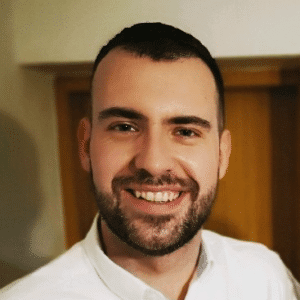 Dr Robert Sakic Trogrlic is Climate and Resilience Officer at Practical Action. His work focuses on building a robust evidence base for ingenious solutions to climate change that work for the poorest and most vulnerable.
Dr Robert Sakic Trogrlic is Climate and Resilience Officer at Practical Action. His work focuses on building a robust evidence base for ingenious solutions to climate change that work for the poorest and most vulnerable.
 Colin McQuistan is Head of Climate and Resilience at Practical Action. He has worked extensively on issues related to the poverty-dimensions of sustainable development, disaster risk reduction and climate change adaptation. His main areas of interest are in systems approaches, complexity, resilience and the challenge of Climate Change.
Colin McQuistan is Head of Climate and Resilience at Practical Action. He has worked extensively on issues related to the poverty-dimensions of sustainable development, disaster risk reduction and climate change adaptation. His main areas of interest are in systems approaches, complexity, resilience and the challenge of Climate Change.
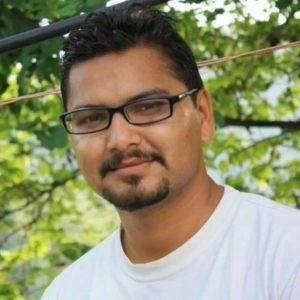 Sunil Acharya is the Regional Advisor for Climate and Resilience at Practical Action. He provides technical advice and support on climate change and disaster risk reduction policy, with a specialist focus on South Asia and Least Developed Countries.
Sunil Acharya is the Regional Advisor for Climate and Resilience at Practical Action. He provides technical advice and support on climate change and disaster risk reduction policy, with a specialist focus on South Asia and Least Developed Countries.
